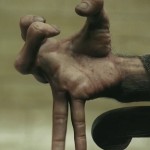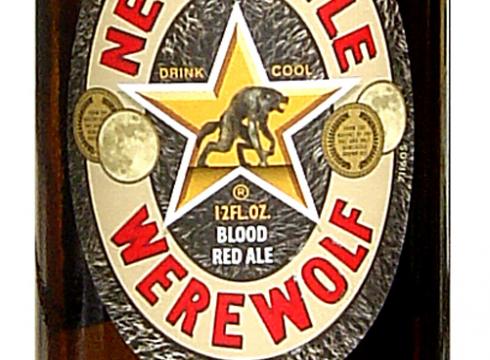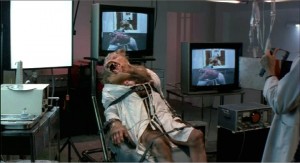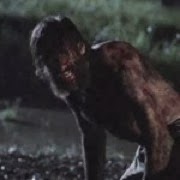
For a long time I’ve been in a Kirk/Picard situation with myself, regarding Ginger Snaps and The Howling: which do I like best? And, I know, what about An American Werewolf in London, Dog Soldiers, Bad Moon. They’re all good and vital, and contributed important stuff, but for me, it’s always come down to Ginger Snaps or The Howling. And I usually settle on The Howling, as it’s got a much stronger ending (much longer franchise tail as well).
But now, man. No, not ‘man.’ Wer.
 This may be the werewolf movie we’ve all been waiting on. And, what’s odd about it? Ever since 1941, the transformation sequence has been key. Landis and Baker took that and drove it home better than anybody, and Hemlock Grove‘s still doing it, to excellent effect. But in Wer, there’s only two real transformations, and neither of them required any dayslong choreography of latex and air-bladders, and the cgi rendering didn’t take a whole wall of processing power. Wer, it’s kind of standing the movie werewolf on its head. As the title might suggest, its stripping all the extra off ‘werewolf,’ just giving us the real monster inside that word all along.*
This may be the werewolf movie we’ve all been waiting on. And, what’s odd about it? Ever since 1941, the transformation sequence has been key. Landis and Baker took that and drove it home better than anybody, and Hemlock Grove‘s still doing it, to excellent effect. But in Wer, there’s only two real transformations, and neither of them required any dayslong choreography of latex and air-bladders, and the cgi rendering didn’t take a whole wall of processing power. Wer, it’s kind of standing the movie werewolf on its head. As the title might suggest, its stripping all the extra off ‘werewolf,’ just giving us the real monster inside that word all along.*
As for why the transformation sequence is so slight—not at all dissatisfying, just not the set-piece it’s always been—it’s not budget, necessarily, it’s that we don’t need to visually chart the ‘shift’ from man to wolf this time. From man to amalgamation of man and wolf, as if a wolf has been laid over the chassis of a man. As if the ‘dangerous’ or best parts of each have come together in some chocolate and peanut-butter perfect storm of an ultimate predator.
Too, I should mention, that’s exactly what I like from my werewolves: not the shoulderpad wolves of Dog Soldiers nor the cat-wolves of Underworld (don’t get me wrong, Lucien’s my sun-and-stars), but something more approaching Streiber’s canis lupus sapiens. Really, this is the silhouette I think a werewolf should cut:

Which is more or less Professor Lupin’s final form, yes? His intermediary one, anyway. Stretched out thin like a greyhound, hair-as-accessory rather than main characteristic, an actual canine muzzle, and on all fours except when the need arises to prairie-dog up over the cubicle walls. A wolf that can persistence hunt, I mean, not just ambush.
And this isn’t to say Wer‘s werewolf isn’t as excellent as excellent gets. When it runs, it drops to all fours, and could probably hurdle a cheetah when that cheetah was really cooking.
Before we get to that werewolf, though, remember how The Wolfman remake does that authentication shuffle—it does it twice, really: on the train (in the dir. cut, I think), Max Van Sydow, in handing off the silver-headed wolf cane we all know and love, drops “Gevaudan,” thereby tipping his hat to all the werewolf aficionados in the crowd that, yes, this movie’s had its homework done, the Beast of Gevaudan is something that matters. But the other way The Wolfman authenticates itself, it’s by having this Lawrence Talbot diagnosed with clinical lycanthropy, which is what always ‘explains away’ the werewolf, as all us die-hards in the crowd know, and kind of despise (this is where The Werewolf of Paris ended once upon a time, yes?). But The Wolfman then earns our undying loyalty when it very publicly disproves that diagnosis, to the consternation and bloody-necked deaths of a lot of gentlemen of the day.
Wer is doing something very similar, here. Except this time we’re the crowd of onlookers, diagnosing this tall, hairy dude with, probably, surely, an advanced case of clinical lycanthropy. We all know he’s the killer, but we suspect he’s just a killer dude, like Peter Stumpf (Stubb, Stump, etc) way back when: somebody who quit shaving and started eating people, starting at the neck.
Then, just like those Victorian gentlemen in The Wolfman‘s 1891, we get disabused of that notion. Pretty wonderfully, too. When this werewolf gets wound up and bitey, it doesn’t matter who’s in the room or what they’re packing, he’s going to chew right through them.
 Especially cool? The nod to Howling III. That’s the marsupial one, yes. Where they use flashing lights to trigger a transformation. The doctors in Wer should have been passing that VHS around before stepping down into this medical theater.
Especially cool? The nod to Howling III. That’s the marsupial one, yes. Where they use flashing lights to trigger a transformation. The doctors in Wer should have been passing that VHS around before stepping down into this medical theater.
Anyway, Ginger Snaps: what made it work was largely that it was a werewolf story embedded within a high school story. The werewolf story undergirded and exaggerated the issues the Fitzgerald sisters were already facing. Wer‘s got a similar angle: this is a werewolf story operating behind the scrim of a legal thriller, a courtroom drama that’s just ramping up to some “You can’t handle the truth”-apotheosis.
Except, of course, things go wrong. If things didn’t go wrong like this in stories, really, we’d stop telling stories. Stop listening to them, anyway.
So, the first half of the film is like footsteps, slowly approaching the werewolf door, peeking up to look in through the small window. Then we get some cool kill scenes, a transformation, and that door’s all the way broken down. The chase is officially started. Across the countryside, in barns, in caves, in caravans, in marshes, the werewolf doesn’t care. All the werewolf wants to do, it’s kill and—this is important—feed.
Far too often our movie werewolves, they just bite and run, right? Like, they hate the world, or throats and shoulders, anyway, and are going to do as much damage as they can before getting gunned down in the street.
Scarier, if you ask me, are those werewolves that are actually preying on us. That want the meat off our thighs. Not just because they don’t always kill us before starting in—though that’s not exactly ideal—but because, if the werewolf’s feeding then that makes it an actual biological animal, instead of some supernatural ‘cursed’ temporary creation. And animals are much easier to believe in, thus, much scarier. Killing one will hardly even matter, right? There’s a breeding population out there somewhere.
 And, talking ‘preying.’ Anybody remember that UPN series Prey from the late nineties? More than anything, Wer reminds me of that: an embedded species, with capabilities far exceeding our own. What’s cool about Wer is that the (extreme) license it takes with porphyria is used to pretty much ‘explain’ werewolves through the ages. And it makes complete and rational sense. And it even takes into account the moon, as all werewolves stories have to address sooner or later (however, silver isn’t an issue. you think it’s going to be, but then it’s not).
And, talking ‘preying.’ Anybody remember that UPN series Prey from the late nineties? More than anything, Wer reminds me of that: an embedded species, with capabilities far exceeding our own. What’s cool about Wer is that the (extreme) license it takes with porphyria is used to pretty much ‘explain’ werewolves through the ages. And it makes complete and rational sense. And it even takes into account the moon, as all werewolves stories have to address sooner or later (however, silver isn’t an issue. you think it’s going to be, but then it’s not).
What’s really, really satisfying about Wer, though, it’s how it manages to both have closure at the end, but in a way that nearly sketches out the rough space where the sequel should be. Very impressed with the writing. And with the directing. And the photography. And the acting. And the effects. And this werewolf. Man, this is bad. Closest analogue I can think of is that tall bearded dude from Cold Prey. Except this werewolf would kill him in a heartbeat.
What’s really, really dissatisfying about Wer? That it didn’t get the wide-release. But it’s coming to DVD in September, I think it is. And it’s so buyable right now, digitally. Get there, werewolf fans. It’s the first new thing we’ve seen in these fields since about 2000. Wer is bringing the werewolf into our world. And it’s a bloody, loud birth. As it should be. My only prayer is that this movie has siblings, and children. We already know the grandparents. What we’re ready for, it’s the next litter.
https://www.youtube.com/watch?v=2ii7I6fKoWs
* however, if we follow through with this, “Godzilla” becomes “God,” “mummies” end up being just “mum,” etc.
** (this footnote has no launch-point above) also, the Jim Harrison of “The Games of Night”—not Wolf—would dig this movie, I think. Can somebody tell him? He’s not in my rolodex.

 is the NYT bestselling author of 30 or so books, +350 stories, some comic books, and all this stuff here. He lives in Boulder, Colorado, and has a few broken-down old trucks, one PhD, and way too many boots. More
is the NYT bestselling author of 30 or so books, +350 stories, some comic books, and all this stuff here. He lives in Boulder, Colorado, and has a few broken-down old trucks, one PhD, and way too many boots. More